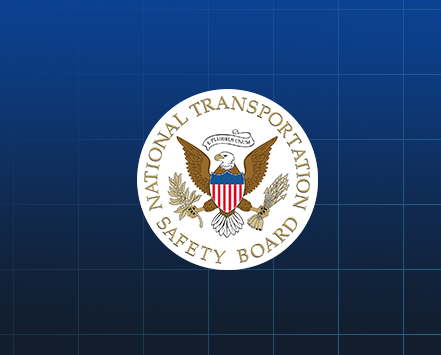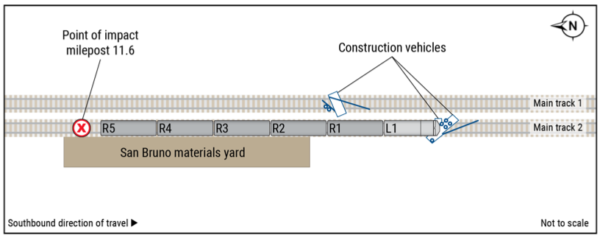NTSB Issues RIR-24-01; Caltrain Train and Hi-rail Construction Vehicles Collision
Written by Jennifer McLawhorn, Managing Editor
SAN BRUNO, Calif. – In a Railroad Investigation Report, the NTSB detailed its investigation about the March 2022 collision between a Caltrain passenger train and three hi-rail construction vehicles.
UPDATE 2/29: Caltrain Executive Director Michelle Bouchard gave a statement below:
“The safety of our personnel and riders is always our first priority. Since the serious event in March 2022, we have taken a number of proactive steps to reinforce a culture of safety within every aspect of our organization that reflects our core values and mission. This includes implementing enhanced roadway worker protection processes, creating several layers of redundancy in clearing track and time, and creating the first dedicated Caltrain Chief Safety Officer to implement new procedures. Additionally, we have become an industry leader in limiting the maximum allowable hours that a roadway protection employee can work per week in order to mitigate risk. The limit on allowable hours is the strongest for any railroad in the country.
As we approach the launch of electrified service later this year, we remain focused on safety because we are acutely aware of all the challenges involved in building infrastructure on an active rail corridor.
We appreciate the NTSB for their work and collaboration and look forward to building on the progress we have made since the events of 2022 to create an even safer Caltrain.”
The National Transportation Safety Board (NTSB) has issued a Railroad Investigation Report detailing a Caltrain passenger train collision with high-rail construction vehicles. The accident occurred on March 10, 2022 at 10:31 a.m. local time when a southbound Caltrain Train 506 (carrying one locomotive and five passenger rail cars) was travelling 64 mph and struck three hi-rail construction vehicles at milepost (MP) 11.6 on Main Track 2 in San Bruno, California. As shown in the image below, the pilot vehicle was facing north, the crane was in the center position facing north, and the boom truck was facing south behind the crane.

The engineer told the NTSB that as the train exited a left-hand track, he could see the construction equipment, but he could not identify which track the equipment was on. The RIR states the event recorder data show the engineer applied the emergency train brake 13 seconds before colliding with the construction equipment. The train’s horn was sounded to alert the construction work group after the emergency brake was applied. Before the train hit the equipment, it had slowed to around 43 mph. The train’s locomotive subsequently derailed and each of the three hi-rail construction vehicles were destroyed. According to the report, eight people were transported to local hospitals and six passengers were treated for minor injuries before being released. The estimated property damage exceeded $1.4 million.
NTSB investigators found that the railway worker-in-charge (RWIC and responsible for managing exclusive track occupancy while monitoring the production and safety of the construction work group) had worked 7 consecutive days in the days leading up to the collision without a rest day. Some of those days, the RWIC had worked 14 hours per day. The NTSB said the work schedule was not the only factor taken into consideration on whether or not he was fatigued. Other factors that could result in fatigue were eliminated in the investigation. Investigators found that the RWIC’s schedule did not rotate between day and night shift and that he “regularly worked during the day and his on-duty start time never varied any more than an hour.” In addition, they found no medical condition nor medications that could affect fatigue.
The RWIC’s workload was investigated, and the NTSB said the incident “suggests that the RWIC’s high workload caused a decrement in his performance that resulted in his loss of awareness of where he was in the process of providing protection for the work crew.” The NTSB wrote that “excess workload can result in human performance errors such as slips (a failure of execution or control, for example, substituting one action for another one in a procedure) and lapses (a failure of memory, including where you are in a procedure).”
The NTSB found the probable cause of the accident is “the roadway worker-in-charge releasing exclusive track occupancy protection leaving workers and construction equipment unprotected on the main track due to his degraded performance from excessive workload.” The entire Railroad Investigation Report can be read below.





